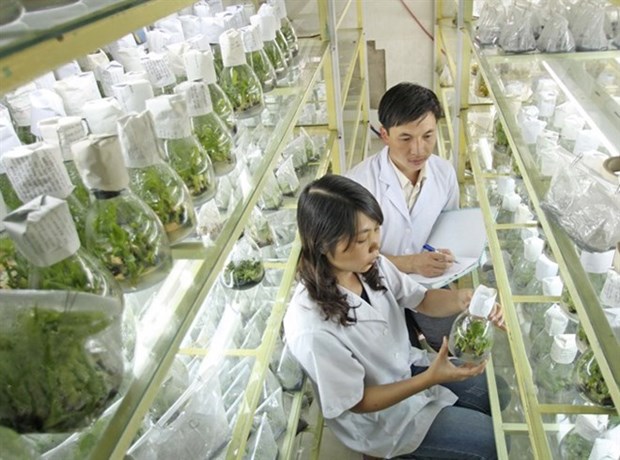Way to 2017 target paved with good intentions
 A hi-tech nursery in Lam Dong province (Photo: VNA)
A hi-tech nursery in Lam Dong province (Photo: VNA)Hanoi (VNA/VNS) – Vo Tri Thanh, a senior economist at the Central Institute for Economic Management (CIEM) and a member of the National Financial and Monetary Policy Advisory Council, has given his analyses of the way to achieve the 2017 GDP target.
He
said late last week, the General Statistics Office of Vietnam announced that
the country’s Gross Domestic Product (GDP) growth in the first half of the year
reached 5.73 percent.
Given that this is the second highest H1 growth rate since 2011, one would
think that it is a good sign for the economy.
However, when compared with the annual growth target of 6.7 percent, the H1
growth seems to fall far short. It is estimated that our GDP must leapfrog by
7.4 percent in the second half of the year to meet the ambitious annual growth
target.
Historically, Vietnam has never seen an H2 GDP increase of 7.4 percent. The
growth rate in the first quarter of this year was 5.1 percent, the lowest in
the last three years. It is worth noting that the country also missed the 6.7
percent growth target last year, reaching only 6.21 percent.
That this target is taken very seriously is evident from the fact that the
Government issued a resolution on the very first day of this year (because the
target was approved by the National Assembly late 2016) in which a series of
tasks and solutions were mapped out for ministries and agencies to improve
their management and deal more effectively with existing problems of the economy.
Never before has GDP growth received so much attention and never before has the
Government been so determined and peremptory that it did not lower the target
despite several economists’ saying that it was not feasible.
As late as June 02, the Prime Minister Nguyen Xuan Phuc issued Directive No
24/CT-TTg to remind ministries and agencies to focus on taking both short and
long-term measures to make the target achievable.
Why is GDP a big deal?
Generally, the GDP is one of the primary indicators used to gauge the health of
an economy. It represents the total value of goods and services produced within
a country’s borders within a specific period of time – monthly, quarterly or
annually. In economics, income, expenditure and production are equal to each other,
meaning that one individual’s spending is another’s income.
So a higher GDP shows an increase in production value added and a rise in the
income of people, which would translate into higher living standards, because
with higher disposable income, people can spend more on quality goods and
services like education and health care.
For developing and lower-middle-income countries like Vietnam, a high GDP
growth is indispensable for catching up with developed and high-income
countries.
Furthermore, GDP growth carries greater import this year because 2017 is an
important transitional year in implementing the 2016-2020 socio-economic
development plan, which sets average growth for the period at 6.5-7 per cent
per year. A failure to reach this year’s target would put much greater
pressure on the remaining years.
In addition, over the past year, the current administration has shown its
determination and efforts to build a constructive, trustworthy Government.
Thus, it is understandable that the Government wants its efforts to achieve
specific, positive and practical results.
However, GDP is not a target that can be achieved merely on a Government’s
aspirations. It depends on business and investment decisions of households and
enterprises in both State-owned and private sectors, foreign and domestic.
These decisions, in turn, depend on internal and external economic factors that
are to some significant extent beyond the State’s control.
In other words, the Government’s management cannot directly yield an increase
in GDP, though it is undeniable that its economic policies have impact on
promoting growth.
Not if, but how
With this rationale in mind, there is no point in debating whether or not the
year’s target of 6.7 per cent is too high, as it has happened recently.
Instead, it is worthwhile discussing how this goal can be achieved.
As mentioned above, the Government has mapped out several short-term solutions.
Now, let’s see whether they suit the long-term plans, targets and directions
that Vietnam wants to follow to ensure sustainable, inclusive
growth.
One of the measures is to increase the output of crude oil beyond the plan
originally assigned by the Prime Minister. This is expected to be the fastest
way to shorten the distance to the 6.7 percent goal.
The Ministry of Industry and Trade has calculated that if an extra million
tonnes of oil were exploited, it would contribute an additional 0.25 percentage
points to the GDP growth rate.
However, this measure is inconsistent with a growth model that is less
dependent on natural resource exploitation, a long-term plan that the
Government wants to realise.
It also does not create more jobs. It would probably have a negative impact on
the environment. Especially important, with the current low global oil prices,
selling crude oil abroad would not earn much profit.
The second measure is to boost credit growth. Some studies have suggested that
as core inflation is still far below 2 percent, the Government has more room to
increase money supply without causing high inflation. But this would send a
wrong message to the market.
Loosening monetary policies could trigger macro-economic instability in the
future, particularly when bad debt is still a lingering obstacle.
Thirdly, the Government wants to increase the public investment. But this is
not an easy assignment because of the budget deficit and high rate of public
debt. So it is necessary to have specific plans and studies to choose which
area/sector would be prioritised for public investment, given the limited State
Budget capacity. More importantly, supervision of public investment projects
must be strengthened. Otherwise, the money would be used inefficiently,
deepening the budget deficit, causing more wastefulness, and hiking public debt
further.
Clearly, short-term administrative interventions, if not carried out
thoroughly, might be counter to long-term efforts of the Government to
stabilise and restructure the macro-economy, and might end up diminishing
stakeholders’ confidence in policy messages.
Of course, there are some jobs that the Government is doing well to promote
growth, like improving the investment environment, encouraging private
investment, opening export markets based on free trade agreements.
But focussing too much on short-term targets and taking measures that are
inconsistent with long-term goals can hurt market confidence and might make the
economy suffer in the long run.
Economist Milton Friedman, who won a Nobel Prize in 1976, famously said: “One
of the great mistakes is to judge policies and programmes by their intentions
rather than their results.”
The Government should avoid this mistake by focusing on measures to stabilise
the macro-economy and to be consistent with long-term goal of more sustainable,
inclusive growth, rather than just on yearly GDP figures.-VNA













